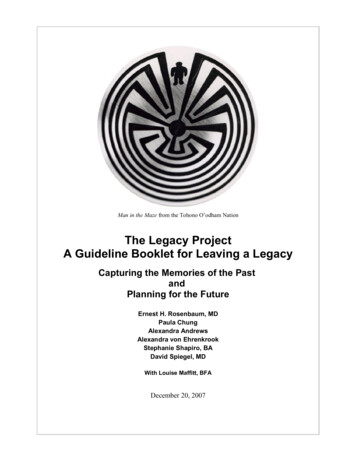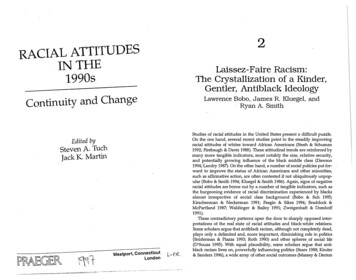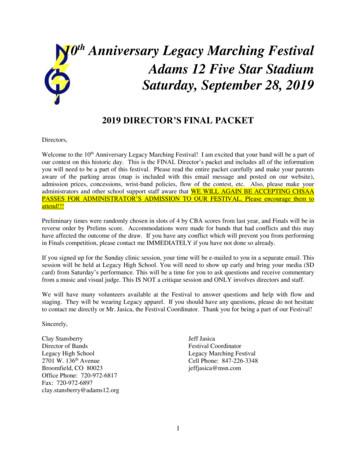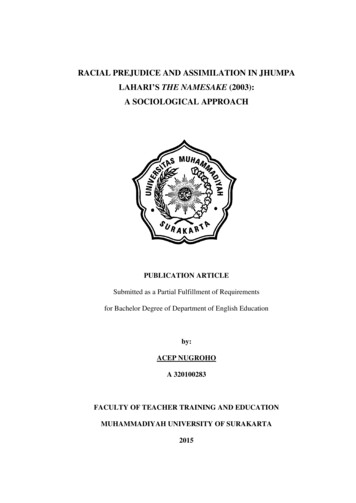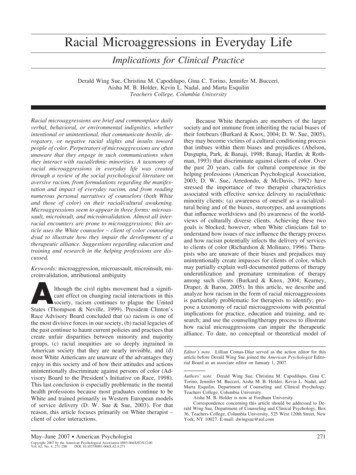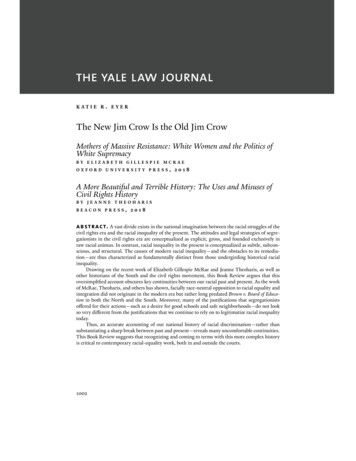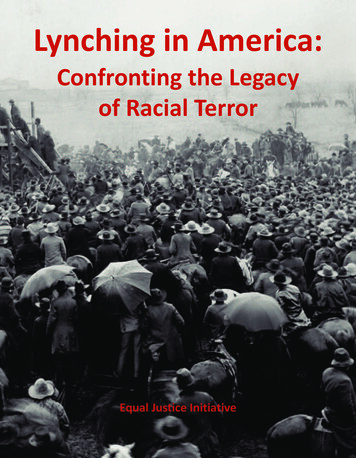
Transcription
Lynching in America:Confronting the Legacyof Racial TerrorEqual Justice Initiative
Men and boys pose beneath the body of Lige Daniels shortly after he was lynched on August 3, 1920, in Center, Texas.From the Civil War until World War II, millions of African Americans wereterrorized and traumatized by the lynching of thousands of black men,women, and children. This report documents this history and contends thatAmerica’s legacy of racial terror must be more fully addressed if racial justiceis to be achieved.1
Lynching in America:Confronting the Legacyof Racial TerrorREPORT SUMMARYEqual Justice Initiative122 Commerce StreetMontgomery, Alabama 36104334.269.1803www.eji.org 2015 by Equal Justice Initiative. All rights reserved. This is a summary only; quoted material is cited inthe full-length report. For a copy of the full-length report, please e-mail EJI at contact us@eji.org or call334.269.1803. No part of this publication may be reproduced, modified, or distributed in any form or byany electronic or mechanical means without express prior written permission of Equal Justice Initiative (EJI).EJI is a nonprofit law organization with offices in Montgomery, Alabama.Opposite: James Allen, ed., et al., Without Sanctuary: Lynching Photography in America (Santa Fe, NM: Twin Palms Publishers, 2000), 117-118. On the cover: 10,000 people gathered to watch the lynching of Henry Smith in Paris, Texas, onFebruary 1, 1893. ( CORBIS.)1
Without memory, our existencewould be barren and opaque, likea prison cell into which no lightpenetrates; like a tomb which rejects theliving . . . [I]f anything can, it is memorythat will save humanity. For me, hopewithout memory is like memory withouthope.- Elie Wiesel2
IntroductionBetween the Civil War and World War II, thousands of African Americans were lynchedin the United States. Lynchings were violent and public acts of torture that traumatizedblack people throughout the country and were largely tolerated by state and federal officials.These lynchings were terrorism. “Terror lynchings” peaked between 1880 and 1940 andclaimed the lives of African American men, women, and children who were forced to endurethe fear, humiliation, and barbarity of this widespread phenomenon unaided.Lynching profoundly impacted race relations in America and shaped the geographic, political, social, and economic conditions of African Americans in ways that are still evidenttoday. Terror lynchings fueled the mass migration of millions of black people from the Southinto urban ghettos in the North and West during the first half of the twentieth century.Lynching created a fearful environment where racial subordination and segregation wasmaintained with limited resistance for decades. Most critically, lynching reinforced a legacyof racial inequality that has never been adequately addressed in America. The administration of criminal justice especially is tangled with the history of lynching in profound waysthat continue to contaminate the integrity and fairness of the justice system.This report begins a necessary conversation to confront the injustice, inequality, anguish,and suffering that racial terror and violence created. The history of terror lynching complicates contemporary issues of race, punishment, crime, and justice. Mass incarceration, excessive penal punishment, disproportionate sentencing of racial minorities, and police abuseof people of color reveal problems in American society that were framed in the terror era.The narrative of racial difference that lynching dramatized continues to haunt us. Avoidinghonest conversation about this history has undermined our ability to build a nation whereracial justice can be achieved.The Context for this ReportIn America, there is a legacy of racial inequality shaped by the enslavement of millionsof black people. The era of slavery was followed by decades of terrorism and racial subordination most dramatically evidenced by lynching. The civil rights movement of the 1950sand 1960s challenged the legality of many of the most racist practices and structures thatsustained racial subordination but the movement was not followed by a continued commitment to truth and reconciliation. Consequently, this legacy of racial inequality has persisted, leaving us vulnerable to a range of problems that continue to reveal racial disparitiesand injustice. EJI believes it is essential that we begin to discuss our history of racial injusticemore soberly and to understand the implications of our past in addressing the challengesof the present.3
Lynching in America is the second in a series of reports that examines the trajectory ofAmerican history from slavery to mass incarceration. In 2013, EJI published Slavery in America, which documents the slavery era and its continuing legacy, and erected three publicmarkers in Montgomery, Alabama, to change the visual landscape of a city and state thathas romanticized the mid-nineteenth century and ignored the devastation and horror created by racialized slavery and the slave trade.Over the past four years, EJI staff have spent thousands of hours researching and documenting terror lynchings in the twelve most active lynching states in America: Alabama,Arkansas, Florida, Georgia, Kentucky, Louisiana, Mississippi, North Carolina, South Carolina, Tennessee, Texas, and Virginia. We distinguish “racial terror lynchings”—the subjectof this report—from hangings and mob violence that followed some criminal trial processor that were committed against non-minorities without the threat of terror. Those lynchingswere a crude form of punishment that did not have the features of “terror lynchings” directed at racial minorities who were being threatened and menaced in multiple ways.We also distinguish “terror lynchings” from racial violence and hate crimes that wereprosecuted as criminal acts. Although criminal prosecution for hate crimes was rare duringthe period we examine, such prosecutions ameliorated those acts of violence and racial animus. The lynchings we document were acts of terrorism because these murders were carried out with impunity, sometimes in broad daylight, often “on the courthouse lawn.” Theselynchings were not “frontier justice,” because they generally took place in communitieswhere there was a functioning criminal justice system that was deemed too good for AfricanAmericans. Terror lynchings were horrific acts of violence whose perpetrators were neverheld accountable. Indeed, some “public spectacle lynchings” were attended by the entirewhite community and conducted as celebratory acts of racial control and domination.Key Findings of this Report4First, racial terror lynching was much more prevalent than previously reported. EJI researchers have documented several hundred more lynchings of African Americans thanthe number identified in the most comprehensive work done on lynching to date. Professor Stewart E. Tolnay’s extraordinary work provided an invaluable resource, as did theresearch collected at Tuskegee University in Tuskegee, Alabama. These two sources arewidely viewed as the most comprehensive collection of research data on the subject oflynching in America. EJI conducted extensive analysis of these data as well as supplementalresearch and investigation of lynchings in each of the subject states. We reviewed localnewspapers, historical archives, and court records; conducted interviews with local historians, survivors, and victims’ descendants; and exhaustively examined contemporaneouslypublished reports in African American newspapers. EJI has documented 3959 lynchings of
black people in twelve Southern states between the end of Reconstruction in 1877 and1950, which is at least 700 more lynchings in these states than previously reported.Second, some states and counties were particularly terrifying places for African Americans and had dramatically higher rates of lynching than other states and counties we reviewed. Florida, Mississippi, Arkansas, and Louisiana had the highest statewide rates oflynching in the United States. Georgia and Mississippi had the highest number of lynchings.Hernando, Taylor, Lafayette, and Citrus counties in Florida; Early and Oconee counties inGeorgia; Fulton County, Kentucky; and Moore County, Tennessee had the highest rates ofterror lynchings in America. Phillips County, Arkansas, and Lafourche and Tensas parishesin Louisiana were sites of mass killings of African Americans in single-incident violence thatmark them as notorious places in the history of racial terror violence. The largest numbersof lynchings were found in Orange, Marion, Alachua, and Polk counties in Florida; Caddo,Bossier, Iberia, Ouachita, and Tanqipahoa parishes in Louisiana; Jefferson and Dallas counties in Alabama; Early and Brooks counties in Georgia; Hinds and Lowndes counties inMississippi; Anderson and McLennan counties in Texas; and Shelby County, Tennessee.Third, our research confirms that many victims of terror lynchings were murdered without being accused of any crime; they were killed for minor social transgressions or for demanding basic rights and fair treatment. Racial terror lynching was a tool used to enforceJim Crow laws and racial segregation—a tactic for maintaining racial control by victimizingthe entire African American community, not merely punishment of an alleged perpetratorfor a crime.Fourth, our conversations with survivors of lynchings show that terror lynching playeda key role in the forced migration of millions of black Americans out of the South. Thousandsof people fled to the North and West out of fear of being lynched. Parents and spousessent away loved ones who suddenly found themselves at risk of being lynched for a minorsocial transgression; they characterized these frantic, desperate escapes as surviving“near-lynchings.”Fifth, in all of the subject states, we observed that there is an astonishing absence ofany effort to acknowledge, discuss, or address lynching. Many of the communities wherelynchings took place have gone to great lengths to erect markers and monuments that memorialize the Civil War, the Confederacy, and historical events during which local power wasviolently reclaimed by white Southerners. These communities celebrate and honor the architects of racial subordination and political leaders known for their belief in white supremacy. There are very few monuments or memorials that address the history and legacyof lynching in particular or the struggle for racial equality more generally. Most communitiesdo not actively or visibly recognize how their race relations were shaped by terror lynching.5
Sixth, we found that most terror lynchings can best be understood as having the featuresof one or more of the following: (1) lynchings that resulted from a wildly distorted fear ofinterracial sex; (2) lynchings in response to casual social transgressions; (3) lynchings basedon allegations of serious violent crime; (4) public spectacle lynchings; (5) lynchings thatescalated into large-scale violence targeting the entire African American community; and(6) lynchings of sharecroppers, ministers, and community leaders who resisted mistreatment, which were most common between 1915 and 1940.Seventh, the decline of lynching in the studied states relied heavily on the increaseduse of capital punishment imposed by court order following an often accelerated trial. Thatthe death penalty’s roots are sunk deep in the legacy of lynching is evidenced by the factthat public executions to mollify the mob continued after the practice was legally banned.Finally, the Equal Justice Initiative believes that our nation must fully address our historyof racial terror and the legacy of racial inequality it has created. This report explores thepower of “truth and reconciliation” or transitional justice to address oppressive historiesby urging communities to honestly and soberly recognize the pain of the past. Only whenwe concretize the experience through discourse, memorials, monuments, and other actsof reconciliation can we overcome the shadows cast by these grievous events.6
Second Slavery After the Civil WarAt the end of the Civil War, the nation did nothing to address the narrative of racial difference that is the most enduring evil of American slavery. Involuntary servitude was horrific for enslaved people, but the ideology of white supremacy was in many ways a moresevere barrier to freedom and equality. White Southern identity was grounded in a beliefthat whites are inherently superior to African Americans. Following the war, whites reactedviolently to the notion that they would now have to treat their former human property asequals and pay for their labor. Plantation owners attacked black people simply for claimingtheir freedom. In May 1866, in Memphis, Tennessee, forty-six African Americans werekilled; ninety-one houses, four churches, and twelve schools were burned to the ground;at least five women were raped; and many black people fled the city permanently.In his 1867 annual message to Congress, President Andrew Johnson declared that blackAmericans had “less capacity for government than any other race of people,” that theywould “relapse into barbarism” if left to their own devices, and that giving them the votewould result in “a tyranny such as this continent has never yet witnessed.” Instead of facilitating black land ownership, President Johnson (a Unionist former slaveholder from Tennessee) advocated a new practice that soon replaced slavery as a primary source ofSouthern agricultural labor: sharecropping.7
Formerly enslaved people were beaten and murdered for asserting they were free after the Civil War. Without federaltroops, freed black men and women remained subject to violence and intimidation for any act or gesture that showedindependence or freedom. (Library of Congress.)Officials struggled to control increasingly violent and lawless groups of white supremacists in their states. Beginning as disparate “social clubs” of former Confederate soldiers,these groups morphed into large paramilitary organizations that drew thousands of members from all sectors of white society. As historian Eric Foner explained, the “wave of counterrevolutionary terror that swept over large parts of the South between 1868 and 1871lacks a counterpart . . . in the American experience.” While white mobs attacked black voters, the United States Supreme Court began an assault on the legal architecture of Reconstruction. Prior to 1865, the Court had only twice struck down congressional acts asunconstitutional; between 1865 and 1872, the Court did so twelve times. A proposal inCongress to discipline Georgia for the violence and corruption surrounding its 1870 electionwas defeated by a five-day filibuster, and Northern support for federal intervention on behalf of black people living in the South diminished considerably.8Undermined by the United States Supreme Court and a Congress that retreated fromprotecting recently emancipated African Americans, Reconstruction collapsed. As oneblack man from Louisiana stated, “The whole South—every state in the South—had gotinto the hands of the very men that held us as slaves.” For millions of black men, women,and children, a new violent and tragic era in America had begun. As Mississippi GovernorAdelbert Ames predicted, “They are to be returned to a condition of serfdom. An era ofsecond slavery.”
The Politics That Created TerrorismWhen Alabama rewrote its constitution in 1901, John B. Knox, president of the constitutional convention, opened the proceedings with a statement of purpose: “Why it iswithin the limits imposed by the Federal Constitution, to establish white supremacy in thisstate.” The South created a system of state and local laws and practices that constituteda pervasive and deep-rooted racial caste system. The era of “second slavery” had officiallybegun. Relying on language in the Thirteenth Amendment that prohibits slavery and involuntary servitude “except as punishment for crime,” lawmakers empowered white-controlled governments to extract black labor in private lease contracts or on state-ownedfarms.By 1890, the term “JimCrow” was used to describethe “subordination andseparation of black peoplein the South, much of itcodified and much of it stillenforced by custom, habit,and violence.” Racial segregation often meant thetotal exclusion of blackpeople from public facilities, institutions, and opportunities.Over thecentury that this racialcaste system reigned, perceived violations of theracial order were met withbrutal violence targeted atblackAmericans—andlynching was the weaponof choice. Southern lynching took on a racializedcharacter, and a brutal eraof racial terror was born.(Thomas Nast/Harper's Weekly, Sept. 5, 1868)9
Lynching in AmericaBy the end of the nineteenth century, Southern lynching had become a tool of racialcontrol that terrorized and targeted African Americans. Through lynching, Southern whitecommunities asserted their racial dominance over the region’s political and economic resources—a dominance first achieved through slavery would be restored through terror.Characteristics of the Lynching EraThe thousands of African Americans lynched between 1880 and 1950 differed in manyrespects, but in most cases, the circumstances of their murders can be categorized as oneor more of the following: (1) lynchings that resulted from a wildly distorted fear of interracial sex; (2) lynchings in response to casual social transgressions; (3) lynchings based onallegations of serious violent crime; (4) public spectacle lynchings; (5) lynchings that escalated into large-scale violence targeting the entire African American community; and (6)lynchings of sharecroppers, ministers, and community leaders who resisted mistreatment,which were most common between 1915 and 1940.Lynchings Based on Fear of Interracial Sex. Nearly 25 percent of the lynchings ofAfrican Americans in the South were based on charges of sexual assault. The mere accusation of rape, even without an identification by the alleged victim, could arouse a lynchmob. The definition of black-on-white “rape” in the South required no allegation of forcebecause white institutions, laws, and most white people rejected the idea that a whitewoman would willingly consent to sex with an African American man.In 1889, in Aberdeen, Mississippi, Keith Bowen allegedly tried to enter a room wherethree white women were sitting; though no further allegation was made against him, Mr.Bowen was lynched by the “entire (white) neighborhood” for his “offense.” General Lee,a black man, was lynched by a white mob in 1904 for merely knocking on the door of awhite woman’s house in Reevesville, South Carolina; and in 1912, Thomas Miles waslynched for allegedly inviting a white woman to have a cold drink with him.Lynchings Based on Minor Social Transgressions. Hundreds of African Americans accused of no serious crime were lynched for social grievances like speaking disrespectfully,refusing to step off the sidewalk, using profane language, using an improper title for awhite person, suing a white man, arguing with a white man, bumping into a white woman,and insulting a white person. African Americans living in the South during this era wereterrorized by the knowledge that they could be lynched if they intentionally or accidentallyviolated any social convention defined by any white person.10
In 1940, Jesse Thornton was lynched in Luverne, Alabama, for referring to a white policeofficer by his name without the title of “mister.” In 1919, a white mob in Blakely, Georgia,lynched William Little, a soldier returning from World War I, for refusing to take off hisArmy uniform. White men lynched Jeff Brown in 1916 in Cedarbluff, Mississippi, for accidentally bumping into a white girl as he ran to catch a train.Lynchings Based on Allegations of Crime. More than half of the lynching victims EJIdocumented were killed under accusation of committing murder or rape. Deep racial hostility in the South during this period focused suspicion on black people, whether evidencesupported that suspicion or not, especially in cases of violent crime against white victims.Whites’ accusations against black people were rarely scrutinized seriously. Of the hundreds of black people lynched under accusation of rape and murder, nearly all were killedwithout being legally convicted. When Berry Noyse was accused of killing the sheriff inLexington, Tennessee, in 1918, an angry mob lynched him in the courthouse square,dragged his body through the town, shot it dozens of times, and burned the body in themiddle of the street below hung banners that read, “This is the way we do our bit.”Jesse Washington was burned before a crowd of thousands in Waco, Texas, in 1916. ( Bettmann/CORBIS.)
Public Spectacle Lynchings. Large crowds of In Dyersburg, Tennessee, awhite people, often numbering in the thousandsmob tortured Lation Scott withand including elected officials and prominent citizens, gathered to witness pre-planned, heinous a hot poker iron, gouging outkillings that featured prolonged torture, mutilation, his eyes, shoving the hot pokerdismemberment, and/or burning of the victim. down his throat and pressing itWhite press justified and promoted these carnival- all over his body beforelike events, with vendors selling food, printers pro- castrating him and burning himducing postcards featuring photographs of thelynching and corpse, and the victim’s body parts alive over a slow fire.collected as souvenirs. These killings were bold,public acts that implicated the entire community and sent a message that African Americans were sub-human, their subjugation was to be achieved through any means necessary,and whites who carried out lynchings would face no legal repercussions.In 1904, after Luther Holbert allegedly killed a local white landowner, he and a blackwoman believed to be his wife were captured by a mob and taken to Doddsville, Mississippi, to be lynched before hundreds of white spectators. Both victims were tied to a treeand forced to hold out their hands while members of the mob methodically chopped offtheir fingers and distributed them as souvenirs. Next, their ears were cut off. Mr. Holbertwas then beaten so severely that his skull was fractured and one of his eyes was left hangLynching of Henry Smith in Paris, Texas, on February 1, 1893 ( CORBIS)12
(National Archives)
ing from its socket. Members of the mob used a large corkscrew to bore holes into thevictims’ bodies and pull out large chunks of “quivering flesh,” after which both victims werethrown onto a raging fire and burned. The white men, women, and children presentwatched the horrific murders while enjoying deviled eggs, lemonade, and whiskey in a picnic-like atmosphere.Lynchings Targeting the Entire African American Community. Some lynch mobs targeted entire black communities by forcing black people to witness lynchings and demanding that they leave the area or face a similar fate. These lynchings were designed for broadimpact—to send a message of domination, to instill fear, and sometimes to drive AfricanAmericans from the community. After a lynching in Forsyth County, Georgia, in 1912, whitevigilantes distributed leaflets demanding that all black people leave the county or sufferdeadly consequences; so many black families fled that, by 1920, the county’s black population had plunged from 1100 to just thirty.To maximize lynching as a terrorizing symbol of power and control over the black community, white mobs frequently chose to lynch victims in a prominent place inside thetown’s African American district. In 1918 in rural Unicoi County, Tennessee, a group ofwhite men sought a black man named Thomas Devert who was accused of kidnapping awhite girl. When the men found Mr. Devert crossing a river with the girl in his arms, theyshot him in the head and the girl drowned. Insisting that the entire black communityneeded to witness Mr. Devert’s fate, the enraged mob dragged his dead body to the townrailyard and built a funeral pyre. The white men then rounded up all sixty African Americanresidents and forced the men, women, and children to watch the corpse burn. TheseAfrican Americans and eighty black people who worked at a local quarry were then told toleave the county within twenty-four hours.Lynchings of Black People Resisting Mistreatment (1915-1940). From 1915 to 1940,whites used lynching to suppress African Americans who, individually and in organizedgroups, were demanding the economic and civil rights to which they were entitled.14In 1918, when Elton Mitchell of Earle, Arkansas, refused to work on a white-ownedfarm without pay, “prominent” white citizens of the city cut him into pieces with butcherknives and hung his remains from a tree. In Hernando, Mississippi, in 1935, when whitelandowners learned that Reverend T. A. Allen was trying to start a sharecropper’s unionamong local impoverished and exploited black laborers, they formed a mob, seized him, shothim many times, and threw him into the Coldwater River. Also in 1935, Joe Spinner Johnson,leader of the Sharecroppers’ Union in Perry County, Alabama, was called from work by hislandlord and delivered to a white gang that tied him “hog-fashion with a board behind hisneck and his hands and feet tied in front of him” and beat him. Mr. Johnson’s mutilated bodywas found several days later in a field near the town of Greensboro.
In 1940, Jesse Thorntonwas lynched in Luverne,Alabama, for referring toa white police officer byhis name without the titleof “mister.”In 1912, Thomas Miles waslynched for allegedlywriting letters to a whitewoman inviting her tohave a cold drink withhim.In 1919, a white mob inBlakely,Georgia,lynched William Little,a soldier returningfrom World War I, forrefusing to take off hisArmy uniform.General Lee, a blackman, was lynched by awhite mob in 1904 formerely knocking onthe door of a whitewoman’s house inReevesville,SouthCarolina.White men lynched JeffBrown in 1916 inCedarbluff, Mississippi,for accidentally bumpinginto a white girl as he ranto catch a train.In 1889, in Aberdeen,Mississippi, Keith Bowenwas lynched after heallegedly tried to enter aroom where three whitewomen were sitting.Lynching in the South, 1877-1950This report documents 3959 lynchings of black people that occurred in Alabama,Arkansas, Florida, Georgia, Kentucky, Louisiana, Mississippi, North Carolina, South Carolina,Tennessee, Texas, and Virginia between 1877 and 1950. The data reveals telling trends acrosstime and region, including that lynchings peaked between 1880 and 1940.Georgia, Mississippi, and Louisiana had the highest absolute number of African American lynching victims during this period. The rankings change when the number of lynchings are considered relative to each state’s total population and African Americanpopulation. Florida, Mississippi, and Arkansas had the highest per capita rates of lynchingby total population, while Arkansas, Florida, and Louisiana had the highest per capita ratesof lynching by African American population. (See Tables 1 and 2.)The twenty-five counties with the highest rates of lynchings of African Americans duringthis era are located in eight of the twelve states studied: Arkansas, Louisiana, Florida, Tennessee, Georgia, Texas, Kentucky, and Mississippi. The terror of lynching was not confinedto a few outlier states. Racial terror cast a shadow of fear across the region. (See Table 3.)15
Table 1: African American Lynching Victims by State, sianaMississippiNorth CarolinaSouth 540576102164225376763959Table 2: Number of African Americans Lynched Annually Per 100,000Residents in Southern States, 1880 to giaAlabamaSouth CarolinaTennesseeTexasKentuckyVirginiaNorth CarolinaPer capita .1110.0720.068
Table 3: 25 Counties With the Most Lynching Victims, -t.25-t.25-t.25-t.CountyPhillips, ARCaddo, LALafourche, LATensas, LAOuachita, LAOrange, FLBossier, LAMarion, FLJefferson, ALDallas, ALEarly, GAIberia, LAAnderson, TXHinds, MSTangipahoa, LABrooks, GAShelby, TNMcLennan, TXAlachua, FLLowndes, MSPolk, FLKemper, MSLeflore, MSWarren, MSColumbia, FLTaylor, FLFulton, KYObion, 19191818181717171717
Enabling an Era of Lynching: Retreat, Resistance, and RefugeThe lynching era was fueled by the movement to restore white supremacy, but Northern and federal officials who failed to act as black people were terrorized and murderedenabled this campaign of racial terrorism. For more than six decades, as Southern whitesused lynching to enforce a post-slavery system of racial dominance, white officials outsidethe South watched and did little.Congress never passed an anti-lynching bill, instead capitulating to Southern politicianswho argued that such legislation constituted racial “favoritism” and violated states’ rights.Southern states passed their own anti-lynching laws to show that federal legislation wasunnecessary, but refused to enforce them. Very few white people were convicted of murder for lynching a black person in America during this period, and of all lynchings committedafter 1900, only 1 percent resulted in a lyncher being convicted of a criminal offense.By 1886, a “New South” controlled by white supremacist leaders PresidentTheodore Rooseveltwas largely established. The domi- declared that “the greatest existingnant political narrative blamedlynching on its victims, insisting that cause of lynching is the perpetration,brutal mob violence was the only ap- especially by black men, of thepropriate response to the growing hideous crime of rape.”scourge of black men raping whitewomen. Southern white politic
Jim Crow laws and racial segregation—a tactic for maintaining racial control by victimizing the entire African American community, not

